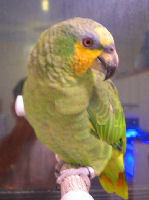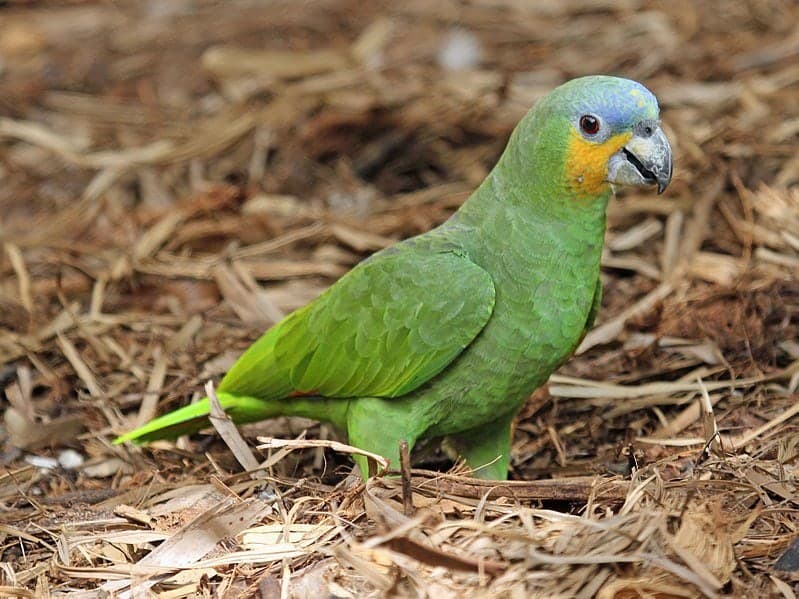The Orange-winged Amazon Amazona amazonica, also known as the Orange-winged Parrot and Loro Guaro, is a very popular pet Amazon. They are very affectionate, attractive, and entertaining parrots. These pet birds are lots of fun, performing all sorts of antics, and have a fair talking ability as well.
While young, like the juvenile above, they are mostly green with just a few of the pretty yellow and blue feathers. Yet when they mature, they are lively, spectacular colored pet birds. Adults have bright yellow-orange and blue feathering on the face and head, and the bright orange on the wings they are named for.
The Orange-winged Amazon has been popular as a pet for over 100 years. Known for being quite friendly, they are easy to tame and quite clever. These parrots also strongly desire the attention of their owners, and will perform all sorts of amusing antics to gain and keep it. They make a wonderful companion and will quickly form a strong bond with their owner, they can however be rather noisy.
This is a robust and hardy bird that can do well indoors or outdoors. As is true with all Amazons, the Orange-winged Amazon is very social and enjoys the company of people as well as other birds. They can also be quite independent, and will probably have a favorite in the family. They can become quite attached to one person if not well-socialized at a young age. But if well socialized, they will treat other members of the family as part of the flock. The Orange-winged parrot is also prone to a hormonal stage as it matures. This is a good choice for an experienced bird keeper who wants to form a close relationship with a parrot.
For more information about Amazon Birds see:
Amazon Parrot: Information and Care
- Kingdom: Animalia
- Phylum: Chordata
- Class: Aves
- Order: Psittaciformes
- Family: Psittacidae
- Genus: Amazona
- Species: amazonica
Scientific name
- Subspecies:
- Amazona amazonica amazonica – nominate species
- Amazona amazonica tobagensis – they are a bit larger than the nominate species, with a more extensive orange found on the speculum (secondary feathers of the wings).
Distribution
The Orange-winged Amazon Amazona amazonica was first described by Linnaeus in 1766. It is also known as the Orange-winged Parrot and Loro Guaro. They are found in most of northern and central South America as well as the islands of Trinidad and Tobago. In the wild they are seen in pairs or flocks, and are sometimes seen in flocks with others species, like the Blue-fronted Amazon Amazona aestiva.
They inhabit all types of forests, damp woods, mangrove swamps, and bamboo clumps. In the wild these birds eat fruits, seeds, nuts, berries, blossoms and leaf buds. They also forage in corn fields and have come to be considered quite a pesky nuisance by the locals.
Status
The Amazona amazonica is on the IUCN Red List for Endangered Species as Least Concern (LC).
Description
The name of the Orange-winged Amazon is derived from a distinct yellow-orange on the bend of the wing and the speculum (secondary feathers of the wings). They also have yellow-orange on the crown and on the front of the cheeks. The rest of the cheek is a bright green and they often fluff their cheeks out, making them look like they have “mutton chop” sideburns.
Their bodies are mostly green from head to tail, with the under parts a bit lighter green. There are hints of blues in the throat and on the crown. The feathers on the back of the neck and upper back are edged with a dusky black. The tail is green tipped with a light yellowish-green, has some oranges on the underside, and some green barring on the top. The beak is a horn color becoming gray at the tip. The eye is orange with a grayish white eye ring, and the legs are a pale gray.
Juveniles are mostly green with few of the yellow-orange or blue feathers seen in the adult. The eyes are a dark brown to grayish brown. Orange-winged Parrots are a medium sized amazons. Mature birds are about 12 – 13 inches (31 – 33 cm) long from the head to the tip of the tail. They reach maturity in about the 4 – 5 year range with a lifespan of 60 plus years.
Care and feeding
In the wild, the diet of the Orange-winged Parrot consists of fruits, plants, seeds and nuts, corn, and probably some protein. A pet bird will enjoy a varied diet, including a quality seed mix or a pelleted diet, and many fresh fruits and vegetables. Plenty of human food that is nutritious can be offered, and they like cheese and chicken. Avocado and chocolate are toxic to any parrot. They like to eat at the table and enjoy eating with their family. They will let you know when it’s dinner time.
Housing
A roomy cage is required for the Orange-winged Amazon. Amazon parrot cages must not be too confining, so get one that your pet will be able to feel comfortable in. It is their territory and their safe place.This parrot likes to climb and play, and enjoys expanding its wings. It is recommended that a cage be 2 x 3 feet wide and 2 1/2 to 5 feet high, and with a play pen top. A great thing is to have a hanging perch above that for climbing.
Orange-winged Parrots can tolerate varying temperatures, but they need to be kept away from any drafts. They love to be out of their cage on a playpen, and will enjoy interacting with their human as well as playing with toys. A variety of perches should be used of varying size and texture. A rougher textured perch instead of the smooth, doll-rod types, makes it easier for them to perch and is better for their feet and legs. A concrete perch can be placed as the highest perch in the cage and next to a toy. At times during the day they will perch there and it will save them (and you) from the ordeal of having their nails filed.
Have fun during bath time. Whether you spritz your amazon with water or an aloe spritz, or just put him in the kitchen sink, make it fun. Your amazon will teach you how he likes to be bathed.
Maintenance
The basic cage care includes daily cleaning of the water and food dishes. Weekly you should wash all the perches and dirty toys, and the floor should be washed about every other week. A total hosing down and disinfecting of an aviary should be done yearly, replacing anything that needs to be freshened, such as old dishes, toys and perches.
Social Behaviors
These parrots enjoy human interaction as well as interaction with other birds. They like to be greeted when you come into the room. They like to eat at the table and will let you know when it’s dinner time. They are quite content and comfortable to be on a perch and in the company of its humans.
 Orange-winged Amazon
Orange-winged Amazon
“Mr. Sonny”
Photo © Animal-World:
Courtesy Ronen Leby
Whether watching TV or eating dinner, the Orange-winged wants to be with you. The more your amazon is around its human counterparts, the more socialized it is and the more it will talk, sing and mimic. You will establish a greater attachment between you and your feathered friend the more you are together.
Handling/Training
The Orange-winged Amazon quickly becomes accustomed to a new environment and its keeper, and is then ready to start bird training. Generally though, you should give a new arrival a few days to get use to you, your voice and its cage before trying to handle it. A hand fed baby will not need much taming and can often be handled right away, as it is use to human attention.
For information about training your Blue Front parrot see: Amazon Parrot Care: Handling and Training
Activities
The Orange-winged is an active amazon and needs plenty of toys. It also needs room to stretch its wings, they love to climb. A hanging perch mounted above the cage top playpen works great. A moveable perch that can follow you around the house is almost a requirement. This parrot likes to play, will make its own music and dance, and is quite an acrobat. They entertain themselves quite well and you will enjoy it.
Sexing – Sexual Differences
Orange-winged Amazons are not sexually dimorphic, females look like males. If gender identification is important (for example for breeding birds) DNA / Feather or surgical sexing is recommended.
Breeding/Reproduction
These Amazons are commonly bred in captivity. But the sexes must be confirmed and the pair must be harmonious, bonded with each other. They will need a nest box that is 31″-39″ (80-100 cm) high with an inside diameter of 12″-14″ (30-35 cm) and an opening of 4″-5″ (10-12 cm). Provide some soft bedding material inside on the bottom of the box.
The hen will lay two to four eggs (sometimes 5) which she will incubate for about 29 days. The young will leave the nest at proximately 9 weeks old. In some cases the female will not feed all the chicks so a breeder will be feeding some from day one.
Potential Problems
The Orange-winged Amazon can be noisy, having a harsh screech. They will make noise early in the morning and when the sun is setting. This usually lasts for about 10 minutes. This is it just waking up and letting you know it is up, or getting ready for bed. These parrots when well cared for will seldom become ill. Though it is often difficult to determine illness, some visible signs of illness to be aware of are:
- ruffled plumage
- listlessness
- drooping wings
- sagging body
- extreme mood changes
- having no appetite
- bulges in feathering
- partially closed or watery eyes
- swelling of the eyelids
- rasping
- difficulty breathing
- excessive saliva
- dirty vent
- any change in the feces not apparently diet related.
Some of the more common illnesses are:
- Psittacosis (chlamydiosis or parrot fever)
- bacterial, viral, or fungal infections
- feather picking (results of boredom, poor diet, sexual frustration, lack of bathing)
- allergies
- chewing flight and tail feathers by juveniles
- beak malformations in chicks
- Papillomas
- kidney disease (gout)
- toxicity
- heavy metal poisoning
- lipomas in older birds.
If you notice any of these bird illnesses in your Orange-winged parrot, immediately provide a warm, draft free, secure environment kept at about 86°F (30°C). Place food and water close to the perch where it is easily accessible. An ailing parrot should be taken to a avian veterinarian for diagnosis and treatment.
Availability
The Orange-winged Amazon or Orange-winged Parrot is readily available and it should be easy to find one in a pet store or from breeders in your area..
References
- Animal-World References: Pet Birds – Exotic Birds
- Dr. David Alderton, The Atlas of Parrots of the World, T.F.H. Publications, Inc. 1991
- David Alderton, Parrots, Salamander Books, 1999
- David Alderton,, A Bird Keeper’s Guide to Parrots and Macaws, Salamander Books, 1989
- Arthur Freud, All About The Parrots, Howell Book House, 1986
- Werner and Susanne Lantermann, Amazon Parrots, Barron’s Educational Series, Inc. 1988
- Orange-winged Amazon, Also Known As: Orange-winged Parrot, World Parrot Trust, copyright 2009
Orange-winged Amazon RWD (Image Credit: DickDaniels, Wikimedia Commons CC BY-SA 3.0 Unported)
